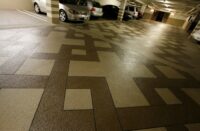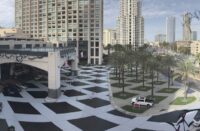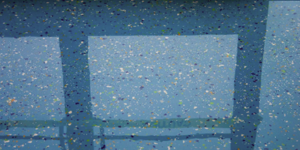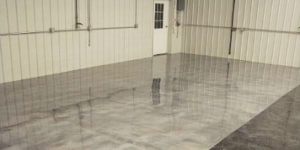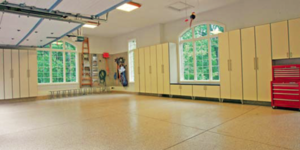
Troy Lemon, president of Cornerstone Decorative Concrete in Holland, Mich., has been using metallics for going on seven years. “I think it’s on the upswing as more commercial operations are moving toward getting a little more glitzy,” he says. He’s also been working hard to bring the product to market, he notes, trying to show it off to two or three designers each time he goes on out-of-town business trips.
He’s had more luck selling jobs to the commercial sector than the residential market. “I was having a harder time with high-end residential designers, but in the last couple of years I’ve been getting them to look at metallics as an up-an-coming thing. And we’ve done some pretty fun jobs,” Lemon says, including putting metallics in an acrylic wax and applying it to a textured fireplace, where it gathered in the recesses.
One nice thing about a metallic coating, in contrast to acid stains or dyes, is its ability to fully cover cracks and other defects, regardless of their size. Lemon says he’s also been using metallic pigments as accents in microtoppings to get certain shading and highlighting effects.
And although most people think a metallic finish has to be shiny or sparkling with a high sheen, it doesn’t have to be that way. The end product can have a matte finish, Lemon says. “It definitely changes the dynamics. You’ll still totally see the metallic effect. It just won’t be shiny.” A lot of his clients prefer the matte look, he adds.
The opposite is true for Michael R. Jensen, CEO of Atlanta Concrete Artist in Georgia. He did his first metallic job several years ago when a client wanted a shiny, iridescent coloring that had the reflective quality of automotive paint. After researching the topic, he ended up using Reflector Enhancer from Elite Crete Systems, which was the only product he found at the time that met the client’s criteria. “It was something people hadn’t seen before,” he says.
Before he knew it, he had several jobs lined up where clients wanted full, vibrant colors to trick out their garages. Although he’s done a few basements and other concrete slabs, custom garage floors remain highest on his request list.
In the past year, he has completed a dozen metallic-looking floors in garages and basements in the greater Atlanta area.
Car enthusiasts request these metallic-type finishes because the vibrant colors mimic the shiny car paint they know and love, Jensen says. “They get the benefit of a hard-wear, sparkling surface that reflects their cars.” Typical homeowners in his area are not requesting these finishes, he notes. “They want something more basic.”
Jensen says he charges more for the metallic-type finishes than he does acid stains or dyes because the floors tend to be more intricate. Many include a pattern, logo or some kind of unusual treatment.
“I think the coolest thing you can do is create a floor that looks 12 inches deep,” Jensen says, adding he uses solvents to thin the material and employs various layering techniques. “The three-dimensional depth you can get from metallics is unlike any other.”
Jensen says he layers different colors or different shades of the same color to create veining, marbling or interesting waves in the floor or to accent certain areas. “I also use an air compressor to push the material around to create a wave effect or crater look.” For the craters, he adds, it’s best to wait 20 to 30 minutes for the material to set up before you hit it with a blast of air.
Jensen, who has been working with iridescent-colored coatings for several years now, says he started out primarily using an epoxy as his carrier but now prefers a polyaspartic. “It’s a much stronger material and you can get the same great-looking floor with much higher scratch resistance. Plus the drying time is so much faster and the client can use the floor the next day. I find the epoxies stay a little soft and you have to coat them with a urethane to protect the finish.” Still, he adds, the choice really depends on the project.
The Atlanta contractor thinks that as more people learn about metallics as an alternative flooring choice, the residential sector of the market will grow. “Homeowners, builders and architects need to see more projects involving metallic surfaces. I don’t think many know it’s out there.”
www.atlantaconcreteartist.com
www.cd-concrete.com
